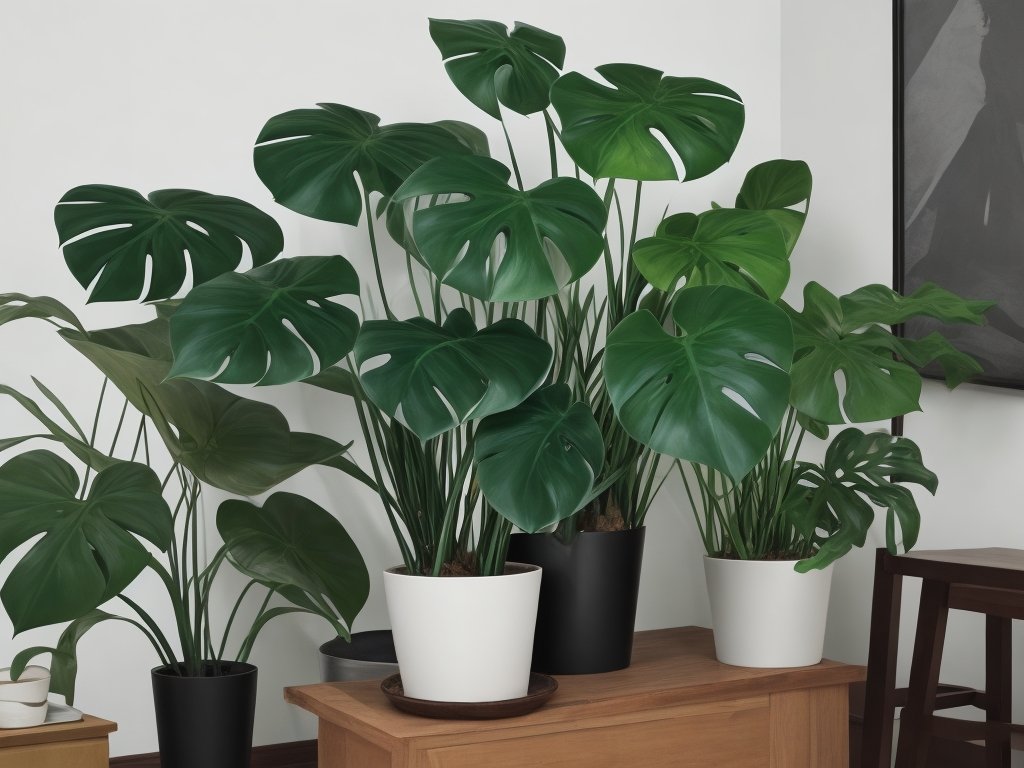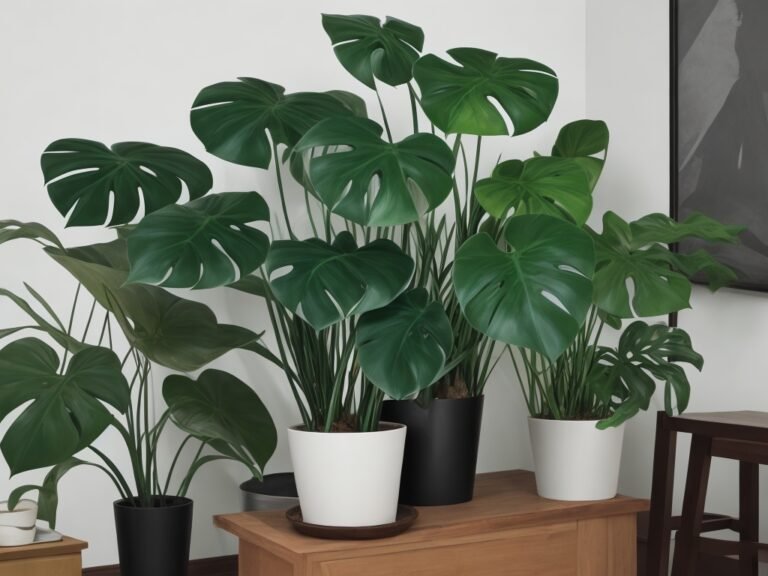Troubleshooting Curling/Drooping Monstera Leaves?
Key Takeaways:
- Curling or drooping Monstera leaves can be caused by overwatering or underwatering.
- Insufficient light can also lead to curling or drooping leaves in Monstera plants.
- Fungal infections and pests such as spider mites can contribute to leaf problems.
- Adjusting watering, improving lighting conditions, and addressing pests can help revive and prevent Monstera leaf issues.
Are your Monstera leaves curling or drooping, leaving you perplexed and worried? Don’t fret, because I’ve got you covered! In this article, we’ll delve into the world of Monstera plants and explore the common issues that can cause their leaves to curl or droop.
From identifying the symptoms to troubleshooting tips and preventive measures, you’ll find everything you need to bring those lush, vibrant leaves back to life.
So, grab your gardening gloves and join me as we embark on a journey to revive your Monstera plants!
| Issue | Possible Causes | Solutions |
|---|---|---|
| Curling leaves |
|
|
| Drooping leaves |
|
|
Understanding Monstera Leaves and Their Common Issues
Monstera leaves play a vital role in the overall health and aesthetics of the plant.
Understanding their characteristics and common issues is key in ensuring proper care.
What is Monstera?
Monstera is a popular tropical plant known for its large, heart-shaped leaves and unique leaf holes. It belongs to the Araceae family and is native to the rainforests of Central and South America.
Monstera plants are loved for their attractive foliage and can be a beautiful addition to any indoor or outdoor space.
Why are Monstera leaves important?
Monstera leaves play a vital role in the overall health and growth of the plant.
They are essential for photosynthesis, the process through which plants convert sunlight into energy.
Additionally, Monstera leaves help regulate transpiration, where the plant releases excess water vapor.
They also contribute to the plant’s aesthetic appeal and can be a sign of the plant’s overall well-being.
Taking care of the leaves is crucial for maintaining a healthy Monstera plant.

Common issues with Monstera leaves
Monstera leaves can face a few common issues. These include curling or drooping leaves, yellowing or browning leaves, and the appearance of spots or streaks.
Other problems may include leaf discoloration, wilting, or stunted growth.
It’s essential to understand the causes behind these issues in order to address and resolve them effectively.
Identifying Curling and Drooping Leaves in Monstera Plants
Identifying curling and drooping leaves in Monstera plants is a key way to understand their health and well-being.
What causes Monstera leaves to curl or droop?
Monstera leaves can curl or droop due to various reasons, such as water issues, lighting problems, nutrient deficiencies, or pests and diseases. Insufficient or excessive watering can disrupt water absorption, while incorrect light conditions can stress the leaves.
Nutrient deficiencies can weaken the plant, and pests and diseases can harm the leaves.
It’s important to identify the specific cause and take appropriate measures to address it.

How to differentiate between curling and drooping leaves?
Curling leaves typically show a twisting or rolling shape, while drooping leaves hang down and appear limp.
Curling can be caused by issues like heat stress or insufficient humidity, while drooping can be a sign of overwatering or root rot.
Observing the leaf shape and considering other symptoms can help identify the problem.

Other symptoms to look for in conjunction with curling or drooping leaves
Other symptoms to look for in conjunction with curling or drooping leaves include yellowing or browning of the leaves, wilting, and stunted growth.
Additionally, if you notice any spots, holes, or webbing on the leaves, it could indicate a pest infestation.
Pay attention to any unusual discoloration or deformities in the leaves as well.

Possible Causes for Curling and Drooping Monstera Leaves
Possible causes for curling and drooping Monstera leaves include impaired water absorption, incorrect light conditions, nutrient deficiencies, and pests or diseases.
Impairment of water absorption in Monstera plants
Impairment of water absorption in Monstera plants occurs when the roots are unable to take up water effectively. This can be caused by overwatering, which leads to root rot, or underwatering, which causes dehydration.
It’s important to find the right balance and ensure proper drainage to maintain healthy water absorption in Monstera plants.
Incorrect light conditions affecting Monstera leaves
Incorrect light conditions can negatively impact the health of Monstera leaves. Insufficient light can cause the leaves to droop and the plant to become leggy.
On the other hand, excessive light can lead to leaf burn and curling.
It is essential to find the right balance, providing bright, indirect light for optimal growth.
Nutrient deficiencies as a potential cause
Nutrient deficiencies can be a potential cause for curling and drooping Monstera leaves.
These plants require a balanced amount of essential nutrients to stay healthy.
If they lack proper nutrition, the leaves may exhibit signs of stress, including curling or drooping.
It is important to ensure that your Monstera is receiving adequate amounts of key nutrients like nitrogen, phosphorus, and potassium.
Monitoring and adjusting the fertilization routine can help prevent nutrient deficiencies and promote healthy leaf growth.
Pests and diseases that may lead to leaf problems
Pests and diseases can cause leaf problems in Monstera plants. Some common pests include spider mites, mealybugs, and aphids, which can cause curling or drooping leaves.
Fungal or bacterial diseases such as root rot or leaf spot can also lead to leaf issues.
Regular pest inspections and proper plant care can help prevent these problems.
Troubleshooting Tips for Curling Monstera Leaves
Having curling Monstera leaves?
Here are some tips to troubleshoot the issue.
Adjusting watering practices for Monstera plants
Adjusting watering practices is crucial for healthy Monstera plants.
Here’s what you should know:
- Water thoroughly but allow the top inch of soil to dry out before watering again.
- Avoid overwatering, as it can lead to root rot and leaf issues.
- Use well-draining soil and pots with drainage holes to prevent waterlogged roots.
- Adjust watering frequency based on environmental conditions, such as humidity and temperature.
- Pay attention to the plant’s response to watering and adjust accordingly. Regularly checking the soil moisture level is key.
Providing appropriate lighting for Monstera leaves
To provide appropriate lighting for Monstera leaves, place them in bright, indirect sunlight. Avoid exposing them to harsh, direct sunlight as it can scorch the leaves.
Additionally, make sure to rotate the plant occasionally to ensure even growth.
If your Monstera is not getting enough light, consider using artificial grow lights to supplement its lighting needs.
Addressing nutrient deficiencies in Monstera plants
To address nutrient deficiencies in Monstera plants, you can:
- Use a balanced fertilizer specifically formulated for houseplants. This will ensure that your Monstera receives all the necessary nutrients.
- Pay attention to the symptoms of nutrient deficiencies, such as yellowing or browning leaves, stunted growth, or leaf discoloration. This will help you identify the specific nutrient that your plant is lacking.
- Adjust your watering routine accordingly. Overwatering or underwatering can both lead to nutrient deficiencies. Make sure to water your Monstera properly and avoid waterlogged soil.
- Regularly inspect the soil pH levels. Monstera plants thrive in slightly acidic to neutral soil. If the pH levels are off, it can affect nutrient availability. Adjust the pH level with appropriate soil amendments if necessary.
- Consider incorporating organic matter, such as compost or worm castings, into the soil. This will enrich the soil with essential nutrients over time.
By addressing nutrient deficiencies, you can help your Monstera plant stay healthy and thrive.
Keep an eye on its overall appearance and adjust your care routine accordingly.
Identifying and treating pests and diseases affecting Monstera leaves
Identifying and treating pests and diseases affecting Monstera leaves:
- Look for common pests like spider mites, mealybugs, and scale insects. Use insecticidal soap or neem oil to treat infestations.
- Monitor for fungal diseases such as leaf spot and root rot. Improve air circulation and avoid over-watering to prevent these issues.
- Treat bacterial infections like bacterial leaf spot with copper-based fungicides.
- Aphids can also affect Monstera leaves. Use a strong stream of water or insecticidal soap to control aphid populations.
- Viral infections cannot be treated, and affected leaves should be removed to prevent spread.
- Regularly inspect and clean your Monstera plant to prevent pests and diseases from taking hold.
Preventive Measures for Healthy Monstera Leaves
To keep your Monstera leaves healthy, focus on proper watering techniques, ideal light conditions, regular nutrient checks and fertilizing, and implementing preventative measures against pests and diseases.
Finding the ideal light conditions for Monstera plants
Monstera plants thrive in bright, indirect light. Avoid direct sunlight, as it can scorch the leaves.
Place your Monstera near a north or east-facing window for ideal lighting.
If your plant is receiving too much light, the leaves may turn yellow. On the other hand, if it’s not getting enough light, the leaves may become pale or smaller.
Finding the right balance of light is key to keeping your Monstera healthy and happy.
Regularly checking for nutrient deficiencies and fertilizing
Regularly checking for nutrient deficiencies and fertilizing are vital for maintaining healthy Monstera leaves.
It’s important to monitor the leaves for signs of discoloration, yellowing, or spots, which could indicate nutrient deficiencies.
By fertilizing with a balanced, water-soluble fertilizer according to the instructions, you can provide the necessary nutrients to keep your Monstera thriving.
Implementing preventative measures against pests and diseases
To prevent pests and diseases in your Monstera plant, here are some preventative measures you can take:
- Regularly inspect your plant: Check for any signs of pests such as mealybugs, spider mites, or aphids. Look for wilting leaves or discoloration that may indicate a disease.
- Quarantine new plants: Before introducing a new Monstera to your collection, isolate it from your existing plants for a few weeks. This helps ensure that it doesn’t bring in any pests or diseases.
- Maintain proper hygiene: Keep your plant and its surrounding area clean. Remove any fallen leaves or debris that might harbor pests or encourage disease growth.
- Provide adequate airflow: Good air circulation helps prevent the buildup of humidity, which can attract pests and diseases. Avoid overcrowding your Monstera plants to allow proper airflow.
- Use organic pest control: If you notice pests on your Monstera, consider using organic pest control methods such as neem oil or insecticidal soap. These options are effective and safe for your plant.
- Avoid overwatering: Overwatering can create a suitable environment for pests and diseases to thrive. Follow appropriate watering practices and ensure proper drainage to prevent waterlogged soil.
- Fertilize appropriately: A well-nourished plant is better equipped to fight off pests and diseases. Use a balanced fertilizer specifically formulated for houseplants, following the recommended dosage.
Frequently Asked Questions about Curling and Drooping Monstera Leaves
How often should I water my Monstera plant?
Water your Monstera plant when the top inch of soil feels dry.
Stick your finger in the soil to check.
Depending on your home’s temperature and humidity, this may be once a week or every two weeks.
Aim for consistent moisture, but avoid overwatering.
Can I save a Monstera leaf that is already curling or drooping?
Yes, you can save a curling or drooping Monstera leaf! Start by identifying and addressing the underlying issue causing the leaf problem.
Adjust watering practices, ensure proper lighting and nutrition, and treat any pests or diseases.
With the right care, the leaf may recover and regain its health.
Will my Monstera leaves return to normal once the issue is resolved?
Yes, once you have identified and resolved the issue causing your Monstera leaves to curl or droop, they have the potential to return to their normal healthy state.
While it may take some time, providing the appropriate care and addressing any underlying problems can help your Monstera leaves recover and regain their characteristic beauty.
Are there any specific pests to watch out for in Monstera plants?
Yes, there are a few specific pests that Monstera plants are prone to. These include spider mites, mealybugs, and aphids.
These pests can cause damage to the leaves and affect the overall health of the plant.
It’s important to regularly inspect your Monstera for any signs of infestation and take prompt action to control and eliminate the pests. Keep an eye out for webbing, small crawling insects, or tiny white cotton-like clusters on the leaves.
Regularly cleaning the leaves and keeping the plant in optimal conditions can help prevent pest problems.
Final Verdict
Understanding and addressing the issues with curling and drooping Monstera leaves is crucial for maintaining the health and vitality of your plant. By identifying the causes, such as water absorption problems, incorrect light conditions, nutrient deficiencies, and pests or diseases, you can take appropriate measures to rectify the situation.
Adjusting watering practices, providing adequate lighting, addressing nutrient deficiencies, and implementing preventive measures against pests and diseases are all essential for ensuring healthy Monstera leaves.
Remember to be proactive in your care routine, as prevention is always better than cure. Your Monstera plant will thank you with lush, vibrant foliage for years to come.





